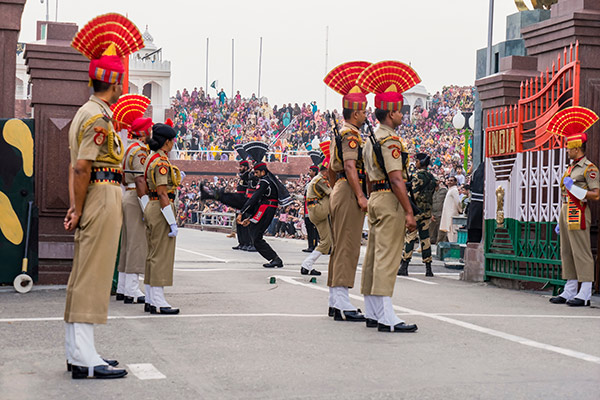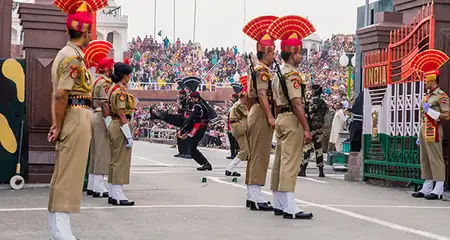Wagah Border near Amritsar is the border crossing that demarcates the boundary between India and Pakistan. Ever since the country gained independence in 1947, it has been serving as a road link between the two countries. It is also a top attraction for travelers, thanks to the Wagah-Attari Border Ceremony that happens here every evening. If you are planning to book your hotels in Amritsar for a holiday trip, keep aside a day to visit the Wagah Border and witness the ceremony.
Want to know more about this top historical place in Amritsar? Here is everything you should know, such as the history, timings, details of the ceremony, and other interesting facts about the Wagah Border.
Wagah Border Information:
| Location | Wagah |
| Distance from Amritsar | 32 km |
| Key Attraction | Wagah-Attari Border Ceremony or Beating Retreat Ceremony |
| Ceremony Timings | 4:15 pm to 5:00 pm (winter); 5:15 pm to 6:00 pm (summer) |
| Ceremony Type | Military practice |
| Entry Fee | Free (seats are allocated on first-come-first-serve basis) |
| Year of Establishment (ceremony) | 1959 |
| Ceremony Conducted by | The Indian Border Security Force and Pakistan Rangers |
| Camera | Permitted |
| Locker Charges | ₹ 50 |
| Others: | You are not permitted to carry bags to the site where the ceremony happens |
| Mobile networks are not available due to jammers in the border area. |
Wagah Border: History
Located about 32 km from Amritsar, Wagah is a village in Pakistan located on the historic Grand Trunk Road that passes between Amritsar and Lahore. The Radcliffe Line or the boundary line dividing India and Pakistan was drawn here, on the Indian side of the village, during the partition of India. This border crossing draws its name from the village where it is located and hence is called Wagah Border. At the time of partition, migrants used this border crossing to travel to Pakistan from India.
Since 1959, both the countries have been conducting the lowering of the flags ceremony here as a daily ritual. In August 2017, India had erected a 110 meter flagpole in Attari, the Indian side of the Wagah Border. In reply, Pakistan came up with a 122 meter flagpole on their side. The flagpole on the Indian side is the highest one in the country while the one on Pakistan’s side is considered to be the tallest one in South Asia.
Wagah Border Ceremony
The Wagah-Attari Border Ceremony or the lowering of the flags ceremony takes place at the border gate between Pakistan and India. This military practice, observed every day since 1959, takes place two hours before the sunset. Conducted by the Indian Border Security Force (BSF) and the Pakistan Rangers, the ceremony attracts tourists from across the country, making the Wagah Border one of the top places to visit in Amritsar.
The ceremony is a 30-minutes drill, the purpose of which is to lower the national flags and formally close the border between the two nations till sunrise. It starts with an elaborate parade conducted by soldiers on both sides of the border. Then, the opening of the iron gates at the border and the lowering of the national flags on both sides take place in perfectly coordinated movements. After the flags are folded, soldiers from both the sides shake hands and the iron gates are closed, marking the end of the ceremony.
The Wagah-Attari Border Ceremony is also known as Beating Retreat Ceremony, which is a symbol of cooperation and brotherhood between the two countries.
Wagah Border: Today
A visit to the Wagah Border ranks among the top things to do in Amritsar. Every evening, a large number of tourists gather here to witness this ceremony. For these people, it is not a mere border ceremony but a display of national pride. Such is the fervor that visitors often sing the national anthem and break into impromptu dances before the ceremony begins.
The site where the ceremony happens is constructed like a stadium and has seating arrangements for visitors. The women guards of India’s Border Security Force have been part of the ceremony since 2011.
Lesser Known Facts
- Both the countries appoint and train soldiers specifically for the Beating Retreat Ceremony.
- Soldiers who take part in the ceremony are required to maintain a moustache and beard for which they are given extra remuneration.
- During the ceremony, soldiers from both the sides march by lifting up their legs as high as possible. This form of marching is known as Goose Marching.
- Wagah was the only road crossing point between India and Pakistan before the Aman Setu became operational in Kashmir in 1999.
- On 1st March 2019, Indian Air Force Wing Commander Abhinandan Varthaman was released from Pakistan and he walked over to India through this border. Since his release was scheduled for post noon, the ceremony was called off on that day due to administrative requirements.
A visit to the Wagah Border is one thing you must not miss out on during your visit to Amritsar. Apart from this border crossing, you can also visit some of the other historical places in Amritsar to make the most of your trip.




























